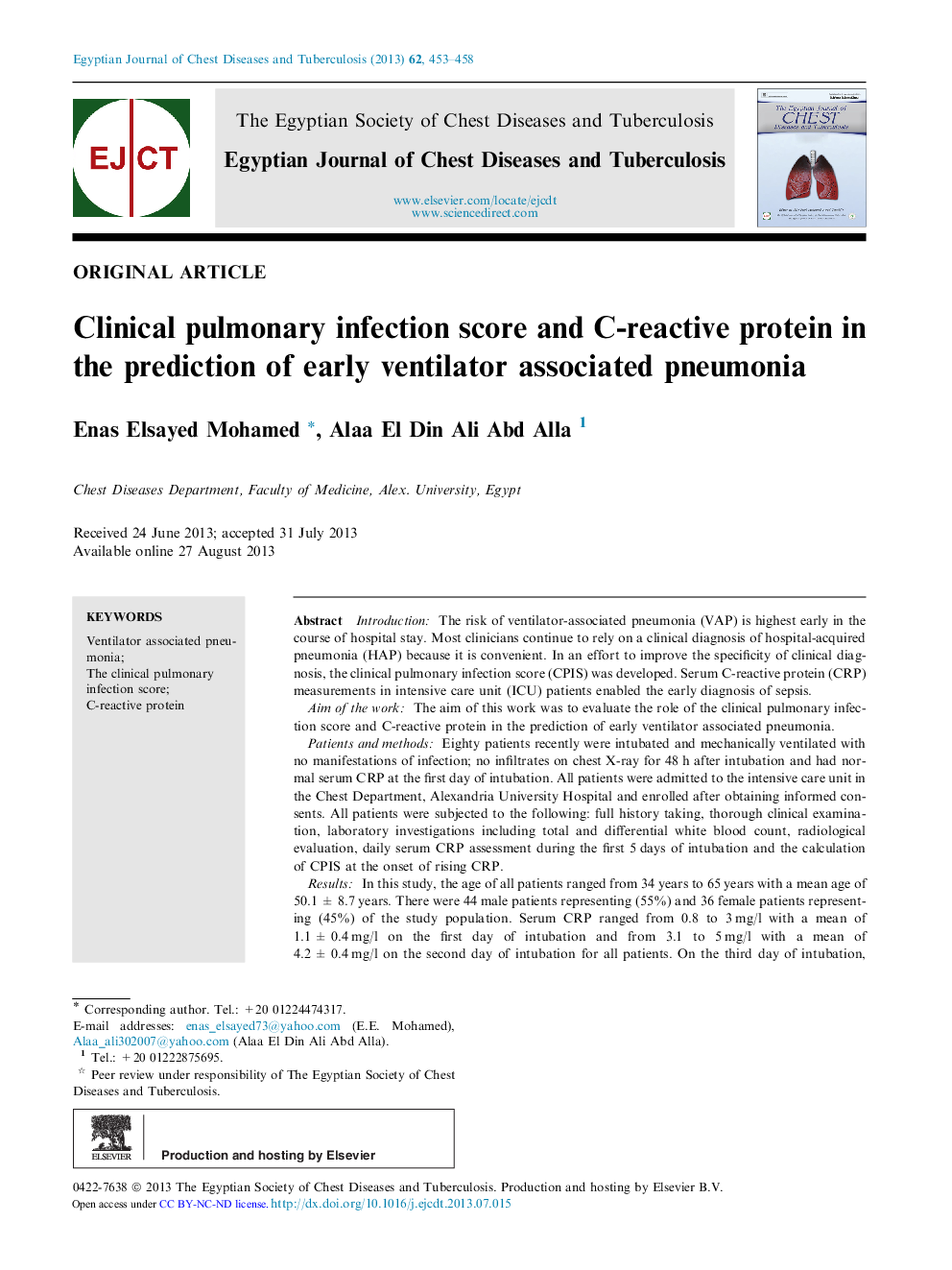| Article ID | Journal | Published Year | Pages | File Type |
|---|---|---|---|---|
| 3400468 | Egyptian Journal of Chest Diseases and Tuberculosis | 2013 | 6 Pages |
IntroductionThe risk of ventilator-associated pneumonia (VAP) is highest early in the course of hospital stay. Most clinicians continue to rely on a clinical diagnosis of hospital-acquired pneumonia (HAP) because it is convenient. In an effort to improve the specificity of clinical diagnosis, the clinical pulmonary infection score (CPIS) was developed. Serum C-reactive protein (CRP) measurements in intensive care unit (ICU) patients enabled the early diagnosis of sepsis.Aim of the workThe aim of this work was to evaluate the role of the clinical pulmonary infection score and C-reactive protein in the prediction of early ventilator associated pneumonia.Patients and methodsEighty patients recently were intubated and mechanically ventilated with no manifestations of infection; no infiltrates on chest X-ray for 48 h after intubation and had normal serum CRP at the first day of intubation. All patients were admitted to the intensive care unit in the Chest Department, Alexandria University Hospital and enrolled after obtaining informed consents. All patients were subjected to the following: full history taking, thorough clinical examination, laboratory investigations including total and differential white blood count, radiological evaluation, daily serum CRP assessment during the first 5 days of intubation and the calculation of CPIS at the onset of rising CRP.ResultsIn this study, the age of all patients ranged from 34 years to 65 years with a mean age of 50.1 ± 8.7 years. There were 44 male patients representing (55%) and 36 female patients representing (45%) of the study population. Serum CRP ranged from 0.8 to 3 mg/l with a mean of 1.1 ± 0.4 mg/l on the first day of intubation and from 3.1 to 5 mg/l with a mean of 4.2 ± 0.4 mg/l on the second day of intubation for all patients. On the third day of intubation, serum CRP ranged from 18 to 38 mg/l with a mean of 27.0 ± 4.7 mg/l in 11 patients while on the fourth day of intubation serum CRP ranged from 32 to 59 mg/l with a mean of 46.2 ± 6.9 mg/l in 12 patients. Lastly, serum CRP ranged from 50 to 66 mg/l with a mean of 60.7 ± 2.6 mg/l on the fifth day of intubation in 9 patients. Therefore, serum CRP increased in 32 patients. CPIS of the studied patients at the onset of rising serum CRP ranged from 7 to 10 in 24 patients. In the first 5 days of intubation, 32 patients out of 80 patients had high CRP, those were 40% of the study population and 24 patients of those 32 patients had high CPIS; those were 30% of the study population and 75% of patients had high CRP.ConclusionWhen the CPIS exceeded 6, there was an association with the presence of pneumonia which was confirmed by microbiological culture furthermore serum CRP is an easy, available and cheap test so daily serum CRP measurements to ICU patients enabled the early diagnosis of pneumonia and enhanced the value of the CPIS. Further studies of CPIS are needed with particular attention to how its variability might affect therapeutic choices.
